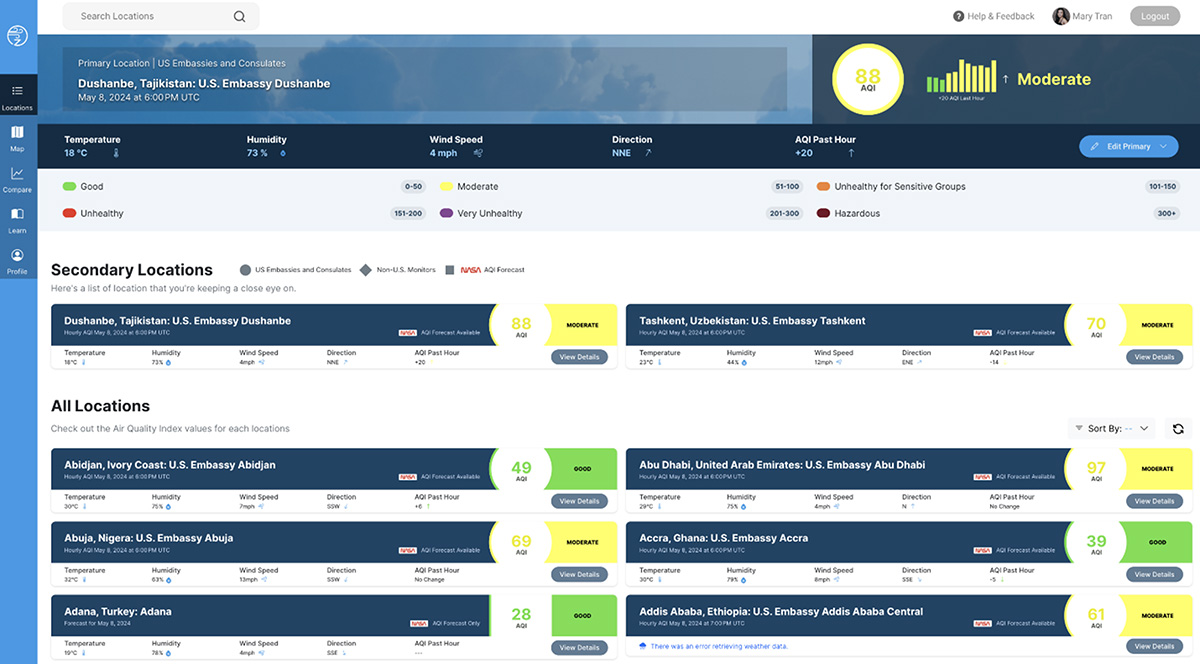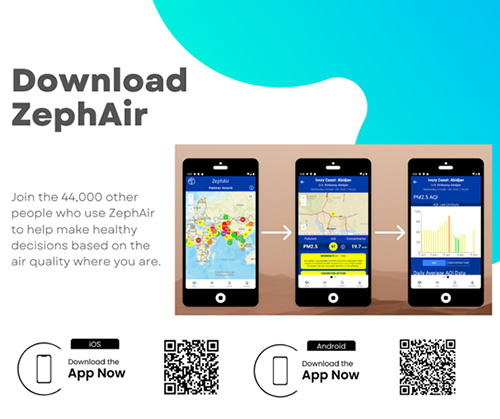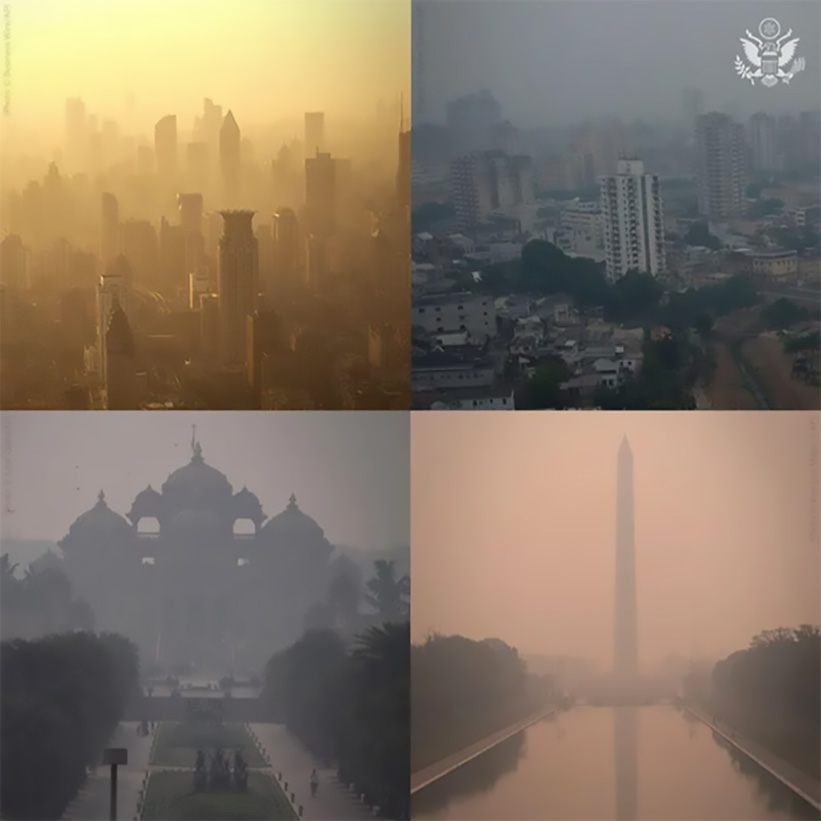AI Air Quality Forecasting: A State-NASA Partnership
A partnership with NASA takes the State Department’s already successful air quality monitoring system to the next level.
BY MARY TRAN

Customizable home page of ZephAir dashboard.
Courtesy of Mary Tran

Advertisement for downloading ZephAir on iOS and Android mobile devices.
Courtesy of Mary Tran
When The Foreign Service Journal published my article about air quality and the Greening Diplomacy Initiative (GDI) in 2021, the world was a different place. We were one year into a global pandemic. Travel restrictions were in full effect. The race to create a vaccine for COVID-19 had begun. And the sky was clear.
Pandemic-related lockdowns had restricted many activities that ordinarily contribute to air pollution such as industry, transportation, and power generation. A study done by The George Washington University showed significant decreases in nitrogen dioxide (NO2) in major urban areas such as Detroit, New York, and Atlanta. The major pollution sources in these areas were heavy commuter routes and international airports; decreases aligned with the reduced vehicle and flight traffic during the domestic lockdown.
There was also unprecedented temporary improvement in air quality around the world. In India, for example, data collected from the European Space Agency’s Sentinel-5P satellite indicated that the levels of air pollution in the northern region of the country were at a 20-year low.
Unfortunately, those temporary gains are now gone, and climate change is worsening air pollution through increased wildfires, drought, and energy demands. And the world still faces massive data gaps, places where no reliable real-time data exists—data that could help forecast potential disasters and allow people to plan their response. (For more on data gaps, please see the article by Ruiz and Ober in this issue.)
And that’s why we are thrilled to announce a new partnership with NASA that makes the State Department’s ZephAir app, already a game changer in providing real-time air quality data, even more powerful. The project represents a leap forward in data availability for those who do not have sufficient ground-based monitors and/or local expertise to develop forecasts. Using historical, satellite, and model data, NASA can now produce an AI-generated air pollution forecast, not just for the 80 embassies and consulates that have ground-based monitors, but for all locations that have embassies and consulates. The implementation of AI ushers in the potential to analyze vast amounts of data to identify pollution patterns and predict future trends. Thanks to machine learning and as we gather more data, the forecasts will improve over time.
This new feature is available now on both the ZephAir mobile app and on the web-based analytics ZephAir dashboard at https://zephair.stategdi.cloud.
Going Global with NASA

Clockwise from top left, air pollution in Shanghai, Mumbai, Washington, D.C., and New Delhi.
U.S. Department of State
In 2015 the Greening Diplomacy Initiative in State’s Office of Management Strategy and Solutions (M/SS) began tracking air quality at posts through our DOSAir monitoring program. DOSAir collects data on pollutant levels in the air using U.S.-made ground-based monitors that have been tested and verified to return trusted data, referred to in the industry as “reference grade.” The monitoring network provides information to the public in areas where there is otherwise a dearth of reliable, public air quality data.
In 2020 we built ZephAir, the department’s first air quality mobile application, to provide an instant look at air quality in the cities where we have air quality monitors.
The air quality monitoring program was a success, but GDI knew that there were still thousands of employees and millions of people who needed air quality information, and we knew we couldn’t meet the need alone. So we turned to another agency with a global—even universal—purview: NASA.
We partnered with NASA Senior Scientist Dr. Pawan Gupta and the health and air quality applied sciences team to compete for a Research Opportunities in Space and Earth Science grant to develop an air quality forecasting capability for more than 260 cities, including all our diplomatic mission locations. The forecast uses artificial intelligence to pull from our ground monitors, satellite data, meteorological variables, and aerosol information to provide a three-day air quality forecast, similar to the ones we all use every day to monitor the weather.
According to Dr. Gupta: “The air quality forecast from NASA integrates cutting-edge global model outputs, satellite observations, and embassy air quality monitors into advanced machine learning algorithms. These forecasts significantly enhance the Department of State’s existing monitoring program by offering near-term air quality predictions, aiding in practical planning efforts. This collaboration exemplifies a robust partnership among federal agencies, leveraging NASA’s research and data to meet the needs of U.S. embassies and American citizens residing abroad.”
This is the first time that a government-developed air quality forecast is available at a global scale. The forecast distinguishes itself in the industry by transparency about the types of air quality monitors it uses, ensuring they are reliable, provide scientific data, and are certified by the Environmental Protection Agency (EPA).
The world still faces massive data gaps, places where no reliable real-time data exists.
According to the department’s Acting Chief Sustainability Officer Caroline D’Angelo: “Our partnership with NASA is a game changer for ZephAir. Their cutting-edge use of AI and satellite data alongside our ground-based data is filling in critical data gaps worldwide. Teaming up makes the best use of both agencies’ resources for a win for public health, the environment, and U.S. science diplomacy.”
Furthermore, as Dr. Gupta points out, the project “presents a unique opportunity for NASA to refine its global air quality forecasting capabilities through collaborations with the Department of State and local partners in host countries.”
Technological Integration and Eco-Diplomacy
GDI is also working on increasing the availability of indoor air quality information through low-cost sensors using a secure wireless network. We’ve installed indoor air quality sensors (LoRaWAN) in Ottawa, Panama City, Tegucigalpa, London, Baghdad, and Naples to provide alternative, affordable options that still provide reliable data. GDI’s Internet of Things (IoT) network provides a secure, stable, and reliable platform for all devices that support DOSAir and the department’s other greening technologies such as MeterNet—a smart metering program to capture real-time energy consumption data at department facilities—and LoRaWAN indoor air quality sensors.
Looking Ahead
When the Journal published my 2021 article, NASA’s forecasting capability was an inkling of an idea. The project’s funding had only recently been secured and we had just begun discussions on where to send additional sensors. To see the rapid progress made by this collaboration between two organizations in the last three years makes me proud to be part of the team. The project has set a high standard for collection, analysis, and dissemination of air quality data that will change international norms and practices in air quality management.
AI and other technologies can significantly enhance our ability to monitor, predict, and mitigate our environmental impact on the planet. When we embrace and lead innovation, we can ultimately use it for the greater good, improving air quality for all.
When sharing or linking to FSJ articles online, which we welcome and encourage, please be sure to cite the magazine (The Foreign Service Journal) and the month and year of publication. Please check the permissions page for further details.
Read More...
- “Breathless in Jakarta—A Cautionary Tale” by Deborah Lynn, The Foreign Service Journal, October 2016
- “Tracking Air Quality: Data for Our Community and Beyond” by Mary Tran, The Foreign Service Journal, October 2021
- “New Air Quality Dashboard Uses AI to Forecast Pollution Levels” by Mary Tran, U.S. Department of State DipNote, May 2024




